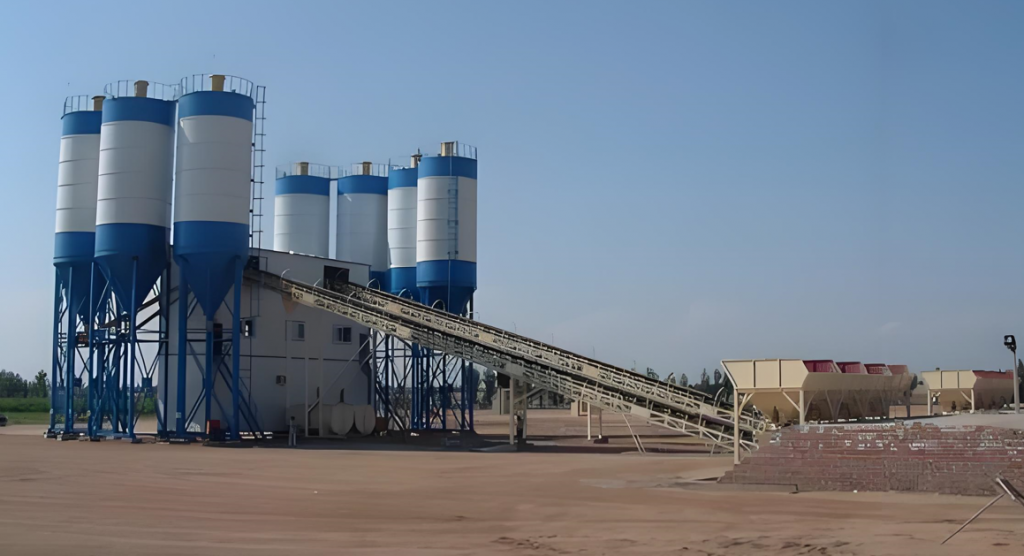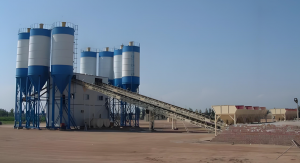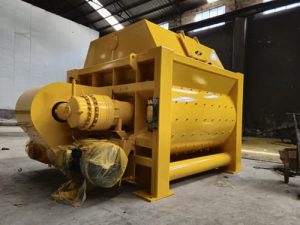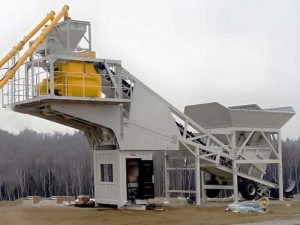Relative News
Products
I. Analysis of technical parameters and system architecture
(I) HZS120 Concrete Batching Plant Core performance indicators
As a green building material equipment certified by the Ministry of Industry and Information Technology, the basic technical parameter system of HZS120 concrete batching plant includes:
1. Mixing system: Equipped with Minrui JS2000 twin-shaft forced concrete mixer, mixing motor power 2x37kW, theoretical cycle number ≥60 times/h
2. Production efficiency: single machine rated capacity under standard working conditions is 120m³/h, and the maximum capacity of dual machine parallel mode can reach 240m³/h
3. Measuring accuracy: aggregate weighing error ≤±2%, powder error ≤±1%, liquid error ≤±0.5%
4. Power configuration: total installed power 198kW, equipped with a dedicated 500kVA substation, supporting 380V±10% voltage fluctuation
5. Structural parameters: the entire HZS120 concrete batching plant covers an area of 50x30m, the equipment net height is 20m, and the positioning tolerance of the foundation embedded parts is ≤3mm
(II) Modular system composition
The HZS120 concrete batching plant equipment adopts a six-in-one modular architecture, and the technical characteristics of each subsystem are as follows:
1. Aggregate supply system: equipped with a four-bin combined batching machine, a single bin capacity of 18-25m³, and a pneumatic arc door mechanism to achieve two-level precise weighing control.
The belt conveyor system adopts DTⅡ type fixed belt conveyor with a belt width of 1000mm, a belt speed of 1.6m/s, and a maximum conveying capacity of 600t/h
2. Powder storage system: including (2-4)x200t cement silos and 2x100t fly ash silos, using vortex pneumatic conveying device, conveying pressure 0.2MPa, conveying speed 1.5t/min
3. Liquid metering system: equipped with dual independent water supply pipelines (clean water/recycled water), equipped with DN50 electromagnetic flowmeter, metering range 0.5-2m³/min. The admixture system includes 4x500L storage tanks and is controlled by a diaphragm metering pump
4. Pneumatic control system: composed of 22kW screw air compressor, 2m³ gas storage tank and solenoid valve group, working pressure 0.5-0.7MPa, gas consumption 1.2m³/min
5. Electrical control system: based on Siemens PLC and WinCC monitoring platform, supports OPC UA protocol, which can realize data docking with ERP system
6. Dust removal system: pulse back-blowing dust collector is used, with a filtration area of 120m², dust removal efficiency ≥99.5%, and emission concentration ≤10mg/m³

II. Optimization design for HZS120 concrete batching plant
(I) Material handling process
1. Aggregate processing stage: loader sends sand and gravel aggregates to batching station → weighing sensor for rough weighing (±5% accuracy) → fine weighing compensation (±0.5% accuracy) → transport through closed belt corridor Delivered to temporary storage
2. Powder conveying process: bulk material truck pneumatically conveyed to silo → screw conveyor quantitatively conveyed to transition bin → dynamic measurement by loss-in-weight scale → pneumatic butterfly valve controls feeding sequence
3. Liquid addition system: clean water is stored in water tank after multi-stage filtration → metering pump accurately injects water according to ratio requirements → admixture is injected through independent pipeline after constant temperature treatment by preheating system
(II) Key points of mixing process control
1. Feeding sequence optimization: adopt segmented feeding of “sand → cement → gravel → water → admixture” material method, the time interval is controlled at 2-5 seconds
2. Mixing parameter setting: mixing shaft speed 36r/min, blade and liner gap 3-5mm, material filling rate controlled at 45-60%
3. Quality control system: equipped with online consistency monitor, adjust water consumption in real time through vibration frequency analysis to ensure slump deviation ≤±10mm
III. Technological innovation and performance advantage analysis
(I) Core technology breakthrough
1. Dynamic compensation weighing technology: adopt high-precision weighing sensor (C3 level) with adaptive filtering algorithm to achieve aggregate weighing error ≤±0.3%
2. Energy recovery system: equipped with flywheel energy storage device, which can recover the braking energy of the mixer and save energy by 18%
3. Intelligent lubrication system: fixed-point lubrication technology based on oil particle size detection, extending the service life of bearings by 40%
(II) Performance comparison analysis
Comparison of data from third-party testing agencies shows (see Table 1):
Indicator item HZS120 Industry average improvement range Production capacity stability 98.7 %92.5%+6.2%Power consumption per ton1.15kW1.38kW-16.7%Fault interval620h450h+37.8%Maintenance cost0.8 yuan/m³1.2 yuan/m³-33.3%
IV. Engineering application practice and scenario adaptation
(I) Analysis of typical application cases
1. Minrui Municipal engineering project: In the construction of Metro Line, the HZS120 concrete batching plant equipment uses a fast conversion system to achieve alternating production of C50 prefabricated segment concrete and C30 shotcrete, with a maximum daily output exceeding 2000m³
2. Minrui Water conservancy and hydropower engineering: Applied to the construction of the diversion tunnel of Hydropower Station, a slow-setting formula is developed for the characteristics of large-volume concrete, the initial setting time is extended to 12 hours, and the temperature rise is controlled to ≤25℃
3. Special environment application: In the Highway reconstruction and expansion project, a low-temperature start-up device and an oxygen content monitoring system are configured to ensure the normal operation of the equipment at an altitude of 4500m
(II) Scenario adaptation plan
1. Commercial HZS120 concrete batching plant configuration: It is recommended to use The dual concrete mixer is arranged in parallel, equipped with a 360° rotating unloading chute, which is suitable for the dispatching needs of 8-12 transport vehicles
2. Temporary engineering plan: Develop a container-type rapid deployment system, which can complete equipment installation and commissioning within 72 hours, and the foundation adopts a recyclable steel structure
3. Environmentally sensitive areas: Integrate sand and gravel separation system and slurry water recovery device to achieve zero wastewater discharge, and noise control ≤55dB(A)
V. Project implementation and operation and maintenance management
(I) Installation and commissioning specifications
1. Foundation construction standards: concrete strength grade ≥C30, embedded parts horizontality deviation ≤1/1000, grounding resistance ≤4Ω
2. Equipment hoisting sequence: mixing host → metering layer → aggregate silo → conveying system → control room, key component positioning accuracy ≤±5mm
3. System debugging process: no-load trial operation → single machine load test → linkage trial production, and continuously assess equipment stability for 72 hours
(II) Operation and maintenance management system
1. Preventive maintenance system: Establish a key component replacement cycle file (see Table 2)
| Part name | Replacement cycle | Test standard |
|————–|———-|———————-|
| Mixing blade | 80,000 m³ | Replacement required if wear ≥5 mm |
| Conveyor belt | 12 months | Surface crack area ≥30% |
| Pneumatic seal | 6 months | Replacement required if leakage rate ≥3% |
2. Intelligent operation and maintenance system: configure vibration monitoring and thermal imaging devices to achieve real-time monitoring and trend analysis of parameters such as bearing temperature and motor current
VI. Economic benefit analysis and technological evolution
(I) Investment return model
Take a commercial concrete station with an annual output of 300,000 m³ as an example:
1. Equipment investment: host system 2.8 million yuan, auxiliary equipment 1.2 million yuan, total investment 4 million yuan
2. Operating cost: electricity 0.8 yuan/m³, labor 1.2 yuan/m³, maintenance 0.6 yuan/m³, total 2.6 yuan/m³
3. Income calculation: calculated based on a gross profit of 30 yuan/m³, investment payback period = 400/(30×30-2.6×30 )=1.83 years
(II) Technology development trends
1. Digital twin technology: Establish a three-dimensional simulation model of HZS120 concrete batching plant equipment to achieve virtual debugging and fault prediction
2. Carbon footprint management: Integrated energy management system to accurately calculate the carbon emissions of a single cubic meter of concrete
3. Flexible manufacturing system: Develop a 5G+MEC edge computing platform to support instant switching of personalized formulas
4. Application of recycled materials: Transform the aggregate preheating system to increase the amount of aggregate in construction waste to 40%
VII. Conclusion and suggestions
Through systematic technological innovation and engineering practice verification, this plan proves that the HZS120 concrete batching plant has significant advantages in production efficiency, energy consumption control and intelligent level. HZS120 concrete batching plant is recommended to focus on the following:
1. Establish a regional spare parts sharing center to shorten maintenance response time
2. Develop a quality traceability system based on blockchain
3. Formulate equipment adaptation standards for special environments such as high altitude and high humidity
4. Explore new business models for equipment leasing and capacity sharing
The research results provide a complete technical reference system for the selection, configuration and upgrading of HZS120 concrete batching plant, which has important practical value for promoting the modernization of the construction industry.


